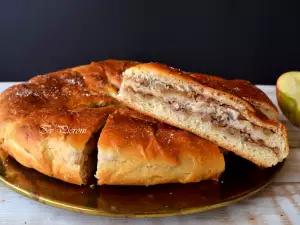How to make
For this Authentic Italian Crispy Sfogliatelle, Naple's delicious dessert, you will need:
- A flat baking tray covered with baking paper;
- Oven 430°F (220°C) and 360°F (180°C).
Dough
Sieve the flour into a bowl, add the salt and mix with a wire whisk. Pour the honey into the middle and pour the water. Knead the dough with your hands. The dough is dry and difficult to work with, but with a little effort it will turn into a ball. If it is impossible to assemble, you can add only up to 1 tbsp. water. It should be firm and dense. Its structure resembles pasta dough.
Knead on a countertop for at least 10 minutes. Place it in a plastic bag and let it rest for at least 2 1/2 hours. After that, the dough will be soft, elastic and easy to work with.
Divide it into three parts. Roll out each part, there is no need to grease the counter or sprinkle it with flour - it is thick enough and does not stick. Roll it out thinly into a rectangle, which is about 28″ (70 cm) long and about 11″ (28 cm) wide.
It can be lifted with your hands and stretched, if the type of flour allows. Grease it completely with 1.8 oz (50 g) of soft butter using your hand. From the narrow side, start rolling it into a very tight roll, this is especially important and should not be skipped. Cover the finished roll with foil and set it aside.
Next up you will need to roll out the next piece of dough, which is the same way and after it is greased with 1.8 oz (50 g) of soft butter, the first roll is placed in the lower part and a general tight rolling of one common roll begins. Cover with foil again and set it aside.
Next up you will need to roll out the third piece of dough, spread it with butter and place it with the previous roll. They are rolled together into a large, tight roll of dough. Once shaped, spread the remaining little butter, which is leftover on the brush or in the container in which the butter was, place it in a large piece of foil and leave it in the refrigerator for at least 12 hours (I will show it in the photo gallery so that you can get a better idea).
Dough
Grate the citrus peels on a fine grater. Set them aside. Remove the pulp from the orange, peel it from the skin and set the pieces aside until they need to be used.
Pour the milk into a thick-bottomed pot, place it on a moderate heat and pour the sugar, stir until it melts. Once it has heated to boiling point, pour all the semolina and immediately stir vigorously until a very thick cream is obtained. Add 1 tsp. vanilla. Stir and leave it to cool.
Pour the ricotta (fine cottage cheese) into a bowl, break the egg on top , add the vanilla, add the grated citrus peels and blend with a mixer until completely smooth.
Place the orange pulp and cinnamon in a deep bowl and mix with a mixer, until a puree is obtained. Once it is completely smooth, pour the flour cream on top, mix again with a mixer until smooth and finally add the cottage cheese mixture. Now beat with the mixer wire whisks until creamy.
Remove the completely cooled roll of dough and cut it into slices, which are about 0.4″ (1/2 cm). Put half the slices back in the refrigerator, the dough is only worked with when cold.
Shaping the dough shells
Take a cut piece, place both thumbs in the middle to form a small hole, without piercing the bottom, and by rotating the fingers from the outside, form a cone, by slightly stretching the dough, slowly and carefully open it, stretch it, without piercing it from any side, so that the layers do not open. Work entirely with the thumbs from the inside. A bell or shell shape should be obtained. Their depth is about 5.5-6 cm.
With a teaspoon, scoop the dairy cream and fill them with it. Press lightly on top, but since the cream is heavy and thick enough, it will not come out during baking.
Arrange them on a tray covered with paper.
Bake at 430°F (220°C) for 10 minutes and then at 360°F (180°C) for 15/20 minutes or until golden brown.
Remove from the oven, cool on a wire rack and cover them well with powdered sugar.
Note: Manitoba flour is not always available, which I specifically save for this type of recipe when fine rolling is required, as it is extremely elastic and does not tear and can be rolled extremely finely, but it can also be replaced with 00 flour.
Ricotta can be replaced with fine unsalted cottage cheese.
I have Semolina and use it a lot, but here, in this recipe, it can be replaced with fine semolina.
The recipe specifies the weights of the products, which must be followed in order to obtain a fine and delicate dough and a good thick cream.
But the most important condition is that the rolls are rolled up very tightly, which, in turn, is a little difficult to do, but with more patience and little effort, you will get a nice roll of dough.
This type of cream is extremely suitable for filling cakes or other types of pastries.
Sfogliatelle (Authentic Neapolitan Pastry) is great!















